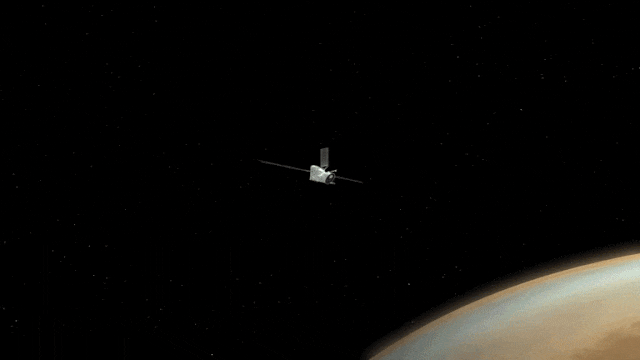All eyes on Venus: 2 spacecraft gear up for close Venus flybys this week
BepiColombo and Solar Orbiter will fly by Venus on Monday (Aug. 9) and Tuesday (Aug. 10), respectively.
Venus is about to get double the extra attention. NASA's Solar Orbiter, in partnership with the European Space Agency (ESA), will hone in on Venus on Aug. 9, but it won't be alone for long. Another ESA spacecraft, BepiColombo (a partnership with the Japan Aerospace Exploration Agency, JAXA) will fly by the planet just one day later.
The spacecraft are both headed toward the inner solar system. Solar Orbiter launched in 2020 with a mission to study the sun, while BepiColombo launched in 2018 and has been en route to Mercury ever since.
On Monday (Aug. 9) Solar Orbiter will approach Venus at a distance of about 4,967 miles (7,995 kilometers). Then on Tuesday (Aug. 10) BepiColombo will approach the planet at about 342 miles (550 km).
Related: Watch Venus glide by in this serene video from the BepiColombo spacecraft's flyby

This won't be either of these missions' first encounters with Venus. The Solar Orbiter spacecraft did its first Venus flyby in December and will make many more trips around the planet over time. BepiColombo, which flew by Venus in October, will head to Mercury next, making its first of six Mercury flybys in October.
Scientists planned for both spacecraft to take advantage of their proximity to Venus on the way to their respective destinations. But it's no lucky accident that they'll both be so close to the planet. Both the Solar Orbiter and BepiColombo need the gravitational swingby of Venus's orbit to help them reach their destinations. Solar Orbiter will use Venus's gravity multiple times to get closer to the sun and to change direction to get a good look at the sun's poles (a first for spacecraft), while BepiColombo needs gravitational help from Earth, Venus and Mercury itself.
According to an ESA statement, the double flyby "offers an unprecedented opportunity to study the Venus environment from different locations at the same time." The spacecraft will also get a look at locations on Venus that aren't usually seen.
Breaking space news, the latest updates on rocket launches, skywatching events and more!
Unfortunately, because Venus is not either spacecraft's main destination, it won't be possible for the cameras aboard either to take high-resolution photos of the planet. Solar Orbiter will have to keep facing the sun, while the main camera aboard BepiColombo will be shielded until the spacecraft is delivered to Mercury, according to ESA.
However, two of BepiColombo's three monitoring cameras will be able to take photos of Venus. The cameras will snap black-and-white images at the time of the spacecraft's approach as well as days afterward. When BepiColombo is closest to Venus, the planet will fill the cameras' views. As the spacecraft moves away from Venus, the planet will be seen passing behind it. ESA expects to see the first image on the evening of Aug. 10, and most of the other images are expected to arrive Aug. 11.
Solar Orbiter may also have a chance to snap images of Venus. The spacecraft's SoloHI imager, which usually takes images of the solar wind, may be able to observe the nightside of Venus in the week before its closest approach, according to ESA. Unfortunately, the spacecraft will be more than 357,000 miles (575,000 km) apart even at their closest, so they will not be able to take photos of each other.
However, images aren't all that these spacecraft are after. Both Solar Orbiter and BepiColombo will collect data on the magnetic and plasma environment of Venus, ESA said. This is where different locations become interesting, as the spacecraft will capture multiple data points of the environment. JAXA's Akatsuki spacecraft is also in orbit around Venus, allowing for an interesting dataset that ESA estimates will take months to meaningfully analyze.
Follow Kasandra Brabaw on Twitter @KassieBrabaw. Follow us on Twitter @Spacedotcom and on Facebook.

Kasandra Brabaw is a freelance science writer who covers space, health, and psychology. She's been writing for Space.com since 2014, covering NASA events, sci-fi entertainment, and space news. In addition to Space.com, Kasandra has written for Prevention, Women's Health, SELF, and other health publications. She has also worked with academics to edit books written for popular audiences.
